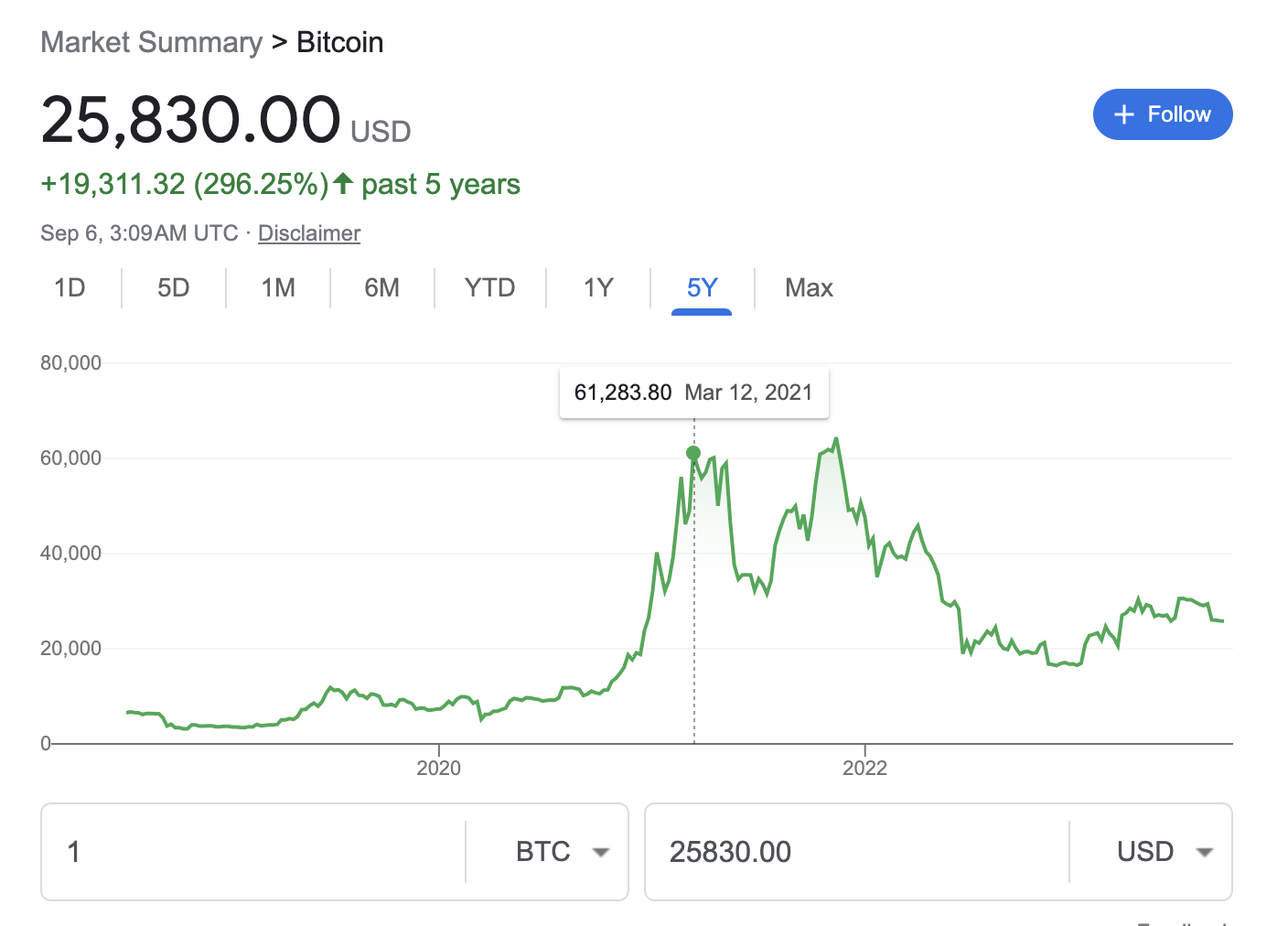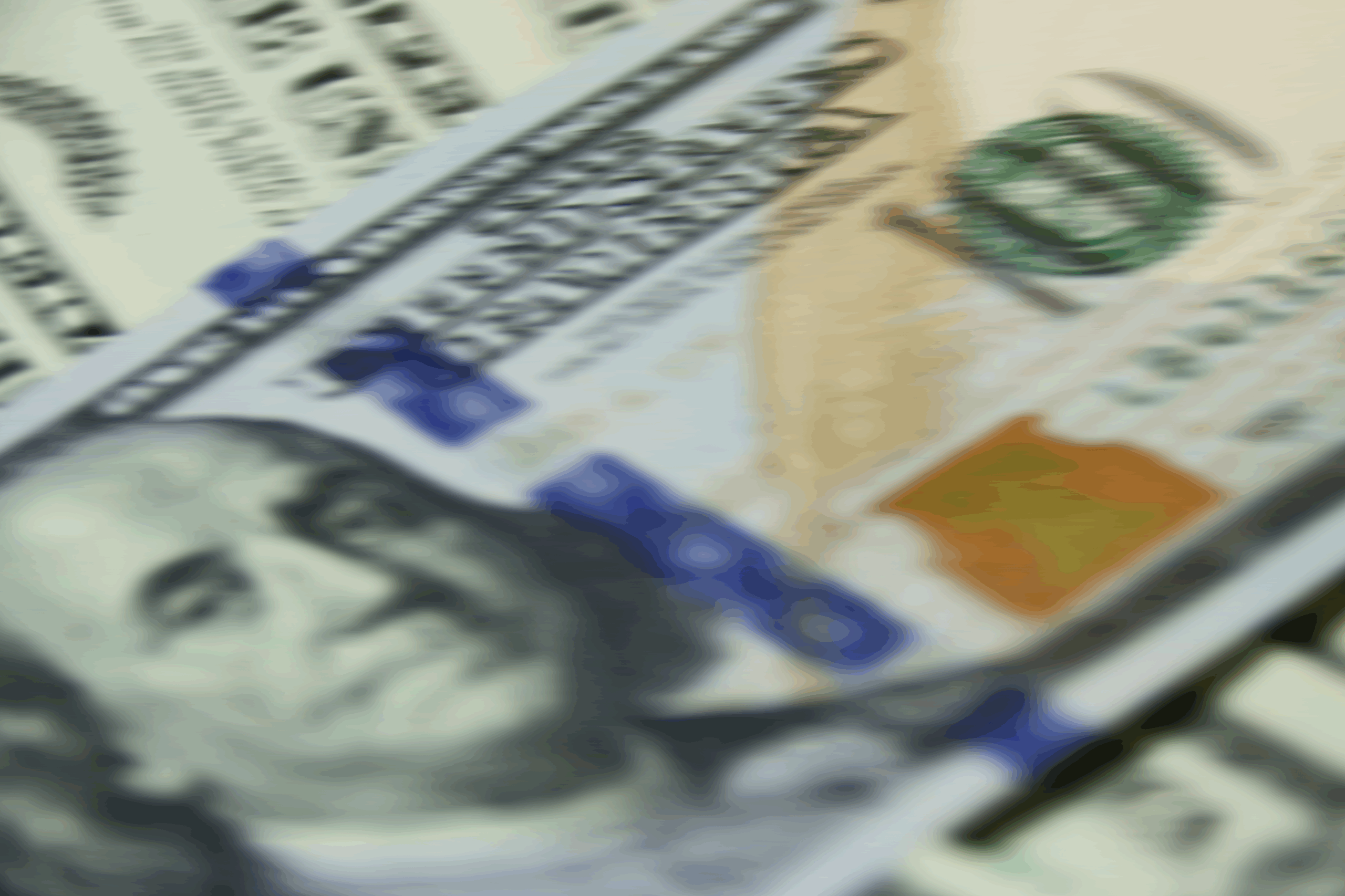Continue Reading
Biggest Finance Newsletter for Women
Join 200,000 other people interested in money, power, culture, and class.
Subscribe
In January 2021, search volume for the term “should I invest in Bitcoin” hit its highest peak, and remained a popular search term through early summer. Bitcoin—and cryptocurrency more generally—was everywhere you looked, infiltrating even the most staid of personal finance domains online (yours truly’s included, as I wrote my first and only cryptocurrency explainer in May 2021, in cautious response to reader demand).
Had you invested at any point during that mountain range-lookin’ peak of search volume that spanned the first five months of the year, you would’ve paid anywhere from $32,150 to $61,284 per coin. (I’m sorry, the fact that in order to discuss the value of Bitcoin one must necessarily clarify how much it costs in US dollars will never not be funny to me.)

So what the hell happened to Bitcoin, which now hovers at less than half of its 2021 peak? The USD’s most uproarious competitor seems to have been relegated to the trash heap for the time being, the laser eyes quietly removed from some of its most popular proponents’ social media profiles online. As quickly as it took the internet (and Google search history) by storm, it mostly vanished from online conversation—replaced by chatter about AI and the future of ChatGPT. It disappeared from our FinTwit lexicon suspiciously quickly.
But the strength of Bitcoin’s rise (and its most recent fall) was bolstered by something we shouldn’t overlook in economics and financial markets: a strong narrative. We’ll be taking a meandering walk down the multi-century timeline that culminated in Lindsay Lohan tweeting “bitcoin to the moon ” and unpacking why it was so powerful and so viral in this week’s episode of The Money with Katie Show. But in the meantime…
>
“The strength of Bitcoin’s rise (and its most recent fall) was bolstered by something we shouldn’t overlook in economics and financial markets: a strong narrative.”
One plot arc in the grand narrative of Bitcoin’s ascendancy was the idea that the central bank’s role in the US economy meant that the S&P 500’s growth wasn’t “real,” and the US dollar was becoming so rapidly devalued as to eventually become totally worthless. (Of course, “history” isn’t over yet, and there’s still a non-zero chance that could be true—but so far, the prophecies of impending doom haven’t come to pass.)
In fact, not only have the S&P 500 and the dollar not collapsed, but had you purchased the S&P 500 using some of your US dollars during that same five-month window in 2021 (when the index was anywhere between 3,825 and 4,204), you’d be up right now anywhere between 6.9% and 17.5%, since the S&P 500 is now—bewilderingly—hovering right around 4,500 again, and the dollar is roughly 13% stronger now than it was in early 2021.
It’s obvious now in hindsight (at least, as of September 2023) that the narrative that pumped Bitcoin to $60,000 was its strongest fundamental. While the patron saints of personal finance (like JL Collins) mostly discouraged investors from getting distracted from the gospel of the index fund, the siren song of returns that would take you “to the moon” were strong, leading many wayward sailors directly onto the craggy shores of Sam Bankman-Fried’s private island.
But even if you ignore the crypto-adjacent legal fallout from fraud and corruption, it’s hard to ignore that Bitcoin just hasn’t been that great an investment (nor inflation hedge) for anyone who bought into the narrative in mid-2021 or later (though it has experienced a bit of a pop from its low in December 2022; again, behaving in a way that’s eerily similar to the very asset class it’s supposedly divorced from, though some pundits claim that correlation is disappearing).
What Bitcoin lacked in cash flow, future earnings, and even the necessary components of a stable currency or store of value, it compensated for with a compelling tale, in spades: a story that had been brewing beneath the surface of US monetary policy since the mid-1900s, but that had only really picked up speed following the global financial crisis of 2008 when institutional trust was at an all-time low.
>
“It’s hard to ignore that Bitcoin just hasn’t been that great an investment (nor inflation hedge) for anyone who bought into the narrative in mid-2021 or later.”
I’m sure there are plenty of people who invest in Bitcoin who earnestly believe in its potential, and it’s important for an impassioned minority to be on the frontier of new technology, whether that be cryptocurrency, artificial intelligence, or otherwise. After all, people originally mocked and attacked the index fund when it was invented, too.
But I won’t miss the taunts to “have fun staying poor,” and I certainly won’t lose sleep over the shitcoin pump ’n dump scams that enriched a very select few by rug-pulling the masses.
As my friend Jack Raines of Young Money wrote in 2021, “Early investors have made millions on Bitcoin, but thanks to low trading volume it’s near impossible to unload a large position in the cryptocurrency without dumping the price. How do you keep the price elevated? You have to bring new money in. How do you do that? Convince naive retail investors that if they buy Bitcoin, they’ll get rich too. Tell them that the US Dollar is destined to fail, and Bitcoin is the only way to preserve their savings. Never let reality get in the way of a good story.”
If Bitcoin is destined to make a comeback anytime soon, I have a feeling the leading indicator will be an event or catastrophe that revives this same narrative: that institutions like the Fed can’t be trusted, the stock market is a shell game, and “hard money” is the solution.
When one sits back and considers the history of money (as we will in the podcast this week), I’m not convinced that’s the future we’re heading for—but regardless, I’m going to keep trading my US dollars for shares of giant US companies with billions of dollars in revenue and hope for something like historical returns. That might make me naïve in the eyes of crypto evangelists, but if there’s one thing I know to be true, it’s that America’s love of capitalism and growth is about as hellbent on “going to the moon” as one can get.
September 11, 2023
Looking for something?
Search all how-to, essays, and podcast episodes.
Explore
While I love diving into investing- and tax law-related data, I am not a financial professional. This is not financial advice, investing advice, or tax advice. The information on this website is for informational and recreational purposes only. Investment products discussed (ETFs, index funds, etc.) are for illustrative purposes only. It is not a recommendation to buy, sell, or otherwise transact in any of the products mentioned. Do your own due diligence. Past performance does not guarantee future returns.
Money with Katie, LLC.
Terms & Conditions | Privacy Policy
This Site Was Built by Brand Good Time



